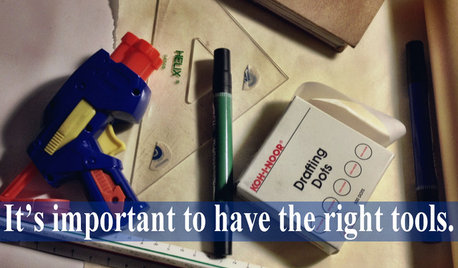Transitioning from TruGreen to Organic - St. Augustine
mayasamsara
15 years ago
Related Stories

HOUZZ TOURSHouzz Tour: From Olden Church to Soaring Modern Marvel
Pray join us on this trip through an incredible home in Melbourne that's a real sanctuary
Full Story
ROOM OF THE DAYDesign Ideas From 21 Much-Loved Rooms
Pick up a trick or two from some of the most popular rooms on Houzz, from a backyard writer’s studio to bright and sunny family rooms
Full Story
EVENTSSneak a Peek at 7 Homes From Denver’s Modern Home Tour
A wine cube with a glass ceiling, a remodeled Eichler and other structures exemplify modern design in Colorado
Full Story
KITCHEN DESIGNGet More From Your Kitchen Island
Display, storage, a room divider — make your kitchen island work harder for you with these examples as inspiration
Full Story
COFFEE WITH AN ARCHITECTWhat My Kids Have Taught Me About Working From Home
Candy and Legos aren't the only things certain small people have brought to my architecture business
Full Story
DECORATING GUIDESHouzz Tour: Traditional Meets Transitional in a Townhouse
A Southern California couple downsizes, and their designer helps them push past traditional boundaries
Full Story
LIVING ROOMSNew This Week: 5 Great Transitional-Style Living Rooms
Find middle ground by blending the formal comfort of traditional style with the casual cool of contemporary
Full Story
TRANSITIONAL HOMESHouzz Tour: New Homeowners Find Their Style
Homework assignments help reveal a couple’s tastes and lead to a home filled with textures and organic tones
Full Story
TOWNHOUSESHouzz Tour: Nature and Technology Combine in a Renovated Townhouse
See how this London property was transformed from a nondescript house into a colorful, high-tech, 21st-century home
Full Story
MODERN HOMESHouzz Tour: Organic Beauty in a Remote Washington Valley
An architect designs almost everything — rugs, light fixtures, counter stools and more — in this modern handcrafted home
Full StorySponsored






dchall_san_antonio
skoot_cat
Related Professionals
Allen Landscape Architects & Landscape Designers · Lyons Landscape Architects & Landscape Designers · Berkley Landscape Contractors · Cary Landscape Contractors · Leicester Landscape Contractors · Mount Kisco Landscape Contractors · West Haverstraw Landscape Contractors · Easton Driveway Installation & Maintenance · Gages Lake Driveway Installation & Maintenance · The Woodlands Driveway Installation & Maintenance · Cockeysville Fence Contractors · La Canada Flintridge Fence Contractors · Peoria Fence Contractors · San Mateo Fence Contractors · Fountain Valley Fence ContractorsmayasamsaraOriginal Author
mayasamsaraOriginal Author
skoot_cat
mayasamsaraOriginal Author
dchall_san_antonio
sandyzz
mayasamsaraOriginal Author
skoot_cat
mayasamsaraOriginal Author
mayasamsaraOriginal Author
robmurphy
skoot_cat
mayasamsaraOriginal Author
skoot_cat
williea
rosarama
dchall_san_antonio
rosarama
greenstay
dchall_san_antonio
greenstay
dchall_san_antonio
lou_spicewood_tx
dchall_san_antonio
rosarama
siz113